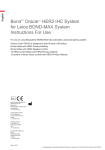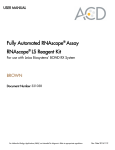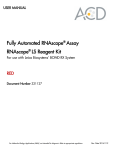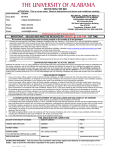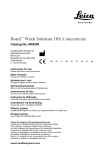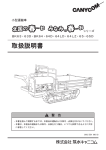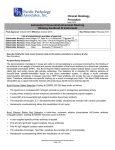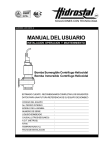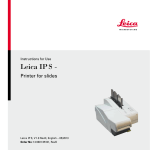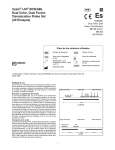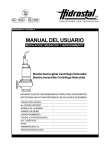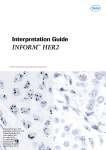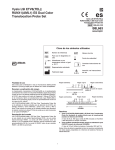Download Leica HER2 FISH System - 30 Test Instructions For Use
Transcript
English Leica HER2 FISH System - 30 Test Instructions For Use For use on Leica Biosystems’ BOND-MAX and BOND-III System. TA9217 is a fluorescence in situ hybridization product designed to stain 30 tests (30 slides stained with LSI HER2/CEP17 Dual Probe). IVD Leica Biosystems Newcastle Ltd Balliol Business Park West Benton Lane Newcastle Upon Tyne NE12 8EW United Kingdom ( +44 191 215 4242 Leica Biosystems Canada 71 Four Valley Drive Concord, Ontario L4K 4V8 Canada ( +1 800 248 0123 Leica Biosystems Inc 1700 Leider Lane Buffalo Grove IL 60089 USA ( +1 800 248 0123 Leica Biosystems Melbourne Pty Ltd 495 Blackburn Road Mt Waverly VIC 3149 Australia ( +61 2 8870 3500 Page 1 of 24 Leica Biosystems Leica HER2 FISH System - 30 Test Instructions for Use TA9217 EN-CE-Rev_D 08/04/2013 Intended Use................................................................................................................................................................................3 For in vitro diagnostic use............................................................................................................................................................................... 3 Required training............................................................................................................................................................................................. 3 Summary and Explanation.........................................................................................................................................................3 Background..................................................................................................................................................................................................... 3 Clinical Concordance Summary Leica BOND-MAX System........................................................................................................................... 4 Clinical Concordance Summary Leica BOND-III System................................................................................................................................ 4 Principle of Procedure..................................................................................................................................................................................... 4 Components Provided..................................................................................................................................................................................... 5 Directions For Use........................................................................................................................................................................................... 5 Storage and Stability....................................................................................................................................................................................... 5 Specimen Preparation..................................................................................................................................................................................... 5 Warnings and Precautions.............................................................................................................................................................................. 6 Procedure.....................................................................................................................................................................................6 A. Reagents required but not supplied............................................................................................................................................................ 6 B. Equipment required but not supplied.......................................................................................................................................................... 6 C. Methodology............................................................................................................................................................................................... 7 D. Bond Enzyme Pretreatment........................................................................................................................................................................ 7 E. Default Staining Protocol............................................................................................................................................................................ 7 F. Procedure Steps......................................................................................................................................................................................... 7 G. Slide Storage.............................................................................................................................................................................................. 8 Signal Assessment and Enumeration.......................................................................................................................................9 Recommended Method for LSI HER2 to CEP17 Ratio Determination.......................................................................................................... 10 Leica HER2 FISH System - 30 Test Interpretation Guide....................................................................................................... 11 Sample Score Sheet..................................................................................................................................................................12 Quality Control...........................................................................................................................................................................13 Limitations.................................................................................................................................................................................13 A. General Limitations................................................................................................................................................................................... 13 B. Product Specific Limitations...................................................................................................................................................................... 14 Clinical Concordance of Leica HER2 FISH System - 30 Test to Abbott Molecular PathVysion HER-2 DNA Probe Kit....14 2x2 Concordance Results Leica BOND-MAX System.................................................................................................................................. 15 2x2 Concordance Results Leica BOND-III System....................................................................................................................................... 16 Precision Testing – Leica BOND-MAX System.......................................................................................................................17 A. Within Run Precision Study...................................................................................................................................................................... 17 B. Within Instrument Precision Study............................................................................................................................................................ 17 C. Between Run Precision Study.................................................................................................................................................................. 17 D. Between Laboratory Precision Study........................................................................................................................................................ 17 E. Between Observer Precision Study.......................................................................................................................................................... 17 F. Lot-to-Lot Precision Study........................................................................................................................................................................ 18 Precision Testing – Leica BOND-III System............................................................................................................................18 G. Within Run Precision Study...................................................................................................................................................................... 18 H. Within Instrument Precision Study............................................................................................................................................................ 18 I. Between Run Precision Study.................................................................................................................................................................. 18 J. Between Laboratory Precision Study........................................................................................................................................................ 18 K. Between Observer Precision Study.......................................................................................................................................................... 19 L. Lot-to-Lot Precision Study........................................................................................................................................................................ 19 Assay Robustness....................................................................................................................................................................19 Troubleshooting........................................................................................................................................................................21 References.................................................................................................................................................................................23 License Agreement...................................................................................................................................................................24 Leica Biosystems Leica HER2 FISH System - 30 Test Instructions for Use TA9217 EN-CE-Rev_D 08/04/2013 Page 2 of 24 English Contents English Intended Use For in vitro diagnostic use The Leica HER2 FISH System - 30 Test is designed to detect amplification of the HER2/neu gene via fluorescence in situ hybridization (FISH) in formalin-fixed, paraffin-embedded human breast cancer tissue specimens. The Leica HER2 FISH System - 30 Test is indicated as an aid in the assessment of patients for whom Herceptin®* (trastuzumab) treatment is being considered (see Herceptin package insert). The Leica HER2 FISH System - 30 Test is not intended for use to screen for or diagnose breast cancer. All other available clinical information should also be taken into consideration, such as tumor size, number of involved lymph nodes, and steroid receptor status. No treatment decision for breast cancer patients should be based on HER2 gene amplification status alone. Note: All of the patients in the Herceptin clinical trials were selected using an investigational immunocytochemical Clinical Trial Assay (CTA). None of the patients in those trials were selected using the Leica HER2 FISH System - 30 Test. The Leica HER2 FISH System - 30 Test has been compared to the Abbott Molecular PathVysion®* HER-2 DNA Probe Kit assay on an independent set of samples and found to provide acceptably concordant results, as indicated in the Clinical Concordance Summary. The actual correlation of the results of the Leica HER2 FISH System - 30 Test to clinical outcome has not been established. * Herceptin® is a trademark of Genentech, Inc. and F. Hoffmann-La Roche Ltd. PathVysion® is a trademark of Abbott Molecular Inc. All Rights Reserved. Used under License. Required training Leica Biosystems will provide training in specimen preparation, assay procedure, and interpretation of FISH testing of the HER2 gene for all users. Summary and Explanation Background The HER2 gene, alternatively known as neu or c-erbB2, is located on the long arm of chromosome 17 at position 17q11-12 (1). Both the HER2 gene and its 185 kD encoded protein have been shown to play a major role in malignant transformation and tumor progression of breast cancer (2). HER2 functions as a prognostic marker, with gene amplification and protein over expression being linked to an increased rate of disease recurrence and higher mortality. HER2 also functions as a predictive marker for selected systemic chemotherapy and targeted treatments (3). Specifically, amplification of the HER2 gene has been shown to be an indicator of poor prognosis in node-positive breast cancer (4-8). Furthermore, one study indicates the prognostic value of HER2 to be stronger among patients treated with chemotherapy (7). However, in predicting disease-free and overall survival in individual patients, other established prognostic factors such as tumor size, number of positive lymph nodes and steroid receptor status must also be taken into consideration. Overexpression of the HER2 oncoprotein, as a result of gene amplification found in breast cancer cells, suggests HER2 as a target for an antibody-based therapy (3). Herceptin (trastuzumab), a humanized monoclonal antibody (9) that binds with high affinity to the HER2 oncoprotein has been shown to inhibit the proliferation of human tumor cells that overexpress HER2 oncoprotein both in vitro and in vivo (10–12). Since the development of Herceptin, the detection of both the HER2 gene and protein have become essential tools in the assessment of breast tumors, directing both therapy selection and subsequent patient management (13,14). In both interphase and metaphase cells derived from human breast carcinoma cell lines, FISH has been used to show HER2 gene amplification (15-18). For quantification of HER2 gene amplification, FISH assesses the level of HER2 gene amplification directly in the tumor cells. Page 3 of 24 Leica Biosystems Leica HER2 FISH System - 30 Test Instructions for Use TA9217 EN-CE-Rev_D 08/04/2013 The Leica HER2 FISH System - 30 Test contains the LSI HER2 DNA probe, a 226 Kb SpectrumOrange™ directly labeled fluorescent DNA probe specific for the HER2 gene locus (17q11.2-q12) and the CEP17 DNA probe, a 5.4 Kb SpectrumGreen™ directly labeled fluorescent DNA probe specific for the alpha satellite DNA sequence at the centromeric region of chromosome 17 (17p11.1-q11.1). The probe solution has been specially formulated and validated for use on the Leica BOND-MAX and BOND-III System and should not be modified or used in a manual setting. Clinical Concordance Summary Leica BOND-MAX System The Leica HER2 FISH System - 30 Test was developed to provide a fully automated alternative to current methodologies used to determine HER2 gene amplification status. The performance of the Leica HER2 FISH System - 30 Test on the Leica BOND-MAX System was evaluated in an independent study comparing the results of the Leica HER2 FISH System - 30 Test to the Abbott Molecular PathVysion HER-2 DNA Probe Kit Assay on 300 breast tumor specimens. None of these tumor specimens were obtained from patients in the Herceptin clinical studies. The results indicated a 99.33% concordance in a 2x2 analysis (95% confidence intervals of 97.61–99.92%). The concordance data also indicates that a positive result with the Leica HER2 FISH System 30 Test is highly likely to correspond with a positive result on the Abbott Molecular PathVysion HER-2 DNA Probe Kit assay. The Leica HER2 FISH System - 30 Test is interpreted as negative for HER2 gene amplification when the HER2:CEP17 gene ratio is less than 2.0 and positive when the HER2:CEP17 gene ratio is greater than or equal to 2.0. Equivocal (borderline) results, where the HER2:CEP17 gene ratio is between or equal to 1.8-2.2, should be interpreted with caution. Count an additional 20 nuclei and recalculate the ratio. Clinical Concordance Summary Leica BOND-III System The Leica HER2 FISH System - 30 Test was developed to provide a fully automated alternative to current methodologies used to determine HER2 gene amplification status. The performance of the Leica HER2 FISH System - 30 Test on the Leica BOND-III System was evaluated in an independent study comparing the results of the Leica HER2 FISH System - 30 Test to the Abbott Molecular PathVysion HER-2 DNA Probe Kit Assay on 300 breast tumor specimens. None of these tumor specimens were obtained from patients in the Herceptin clinical studies. The results indicated a 99.67% concordance in a 2x2 analysis (95% confidence intervals of 98.16–99.99%). The concordance data also indicates that a positive result with the Leica HER2 FISH System 30 Test is highly likely to correspond with a positive result on the Abbott Molecular PathVysion HER-2 DNA Probe Kit assay. The Leica HER2 FISH System - 30 Test is interpreted as negative for HER2 gene amplification when the HER2:CEP17 gene ratio is less than 2.0 and positive when the HER2:CEP17 gene ratio is greater than or equal to 2.0. Equivocal (borderline) results, where the HER2:CEP17 gene ratio is between or equal to 1.8-2.2, should be interpreted with caution. Count an additional 20 nuclei and recalculate the ratio. Principle of Procedure The Leica HER2 FISH System - 30 Test contains components required to complete a fluorescence in situ hybridization based staining procedure for formalin-fixed, paraffin-embedded tissues. Following appropriate pretreatment, incubation with the ready-to-use LSI HER2/CEP17 Dual Probe and appropriate stringency washing, tissue sections are then dehydrated and mounted with DAPI. Results are interpreted by fluorescence microscopy using the recommended filters at the appropriate wavelengths. Leica Biosystems Leica HER2 FISH System - 30 Test Instructions for Use TA9217 EN-CE-Rev_D 08/04/2013 Page 4 of 24 English The characteristic morphology of the tissue and the spatial distribution of oncogene copies in individual uncultured primary breast carcinomas are retained. Aberrations in chromosome 17 copy number (aneusomy) are also commonly found in breast tumors. These may present as chromosome deletions or gains (polysomy). This chromosomal variation has critical impact on the interpretation and reporting of HER2 gene amplification status. Therefore, measurement of chromosome 17 copy number in conjunction with HER2 is critically important (4). English The Leica HER2 FISH System - 30 Test is for use only on the Leica BOND-MAX and BOND-III System. Components Provided The materials listed below (Table 1) are sufficient to stain 30 tests (30 slides stained with LSI HER2/CEP17 Dual Probe). LSI HER2/CEP17 Probe 6.6 mL Post Hybridization Wash 2 9 mL Leica BOND Enzyme Concentrate 2 Contains ready-to-use LSI HER2/CEP17 Dual Probe. Contains <60% (v/v) formamide. Contains ready-to-use post hybridization wash solution. Contains <50% (v/v) formamide. Contains Proteinase K solution at 1.7 mg/mL. 1 mL Leica BOND Enzyme Diluent Contains Enzyme Diluent. 65 mL Leica BOND Open Container BOND Open Container used for Enzyme 5. 3 x 7 mL Table 1: Leica HER2 FISH System - 30 Test Components Refer to individual MSDS for further product safety information, available from www.LeicaBiosystems.com/TA9217-IFU Directions For Use All reagents supplied are formulated specifically for use with this assay and lot numbers are specific for each Leica HER2 FISH System - 30 Test. For the assay to be valid, no substitutions should be made. Storage and Stability Store at 2–8 °C. Do not freeze. Return to 2–8 °C immediately after use. Any deviation from these conditions will invalidate the assay. Ensure the Leica HER2 FISH System - 30 Test is used within its designated expiry date. The signs indicating contamination and/or instability of the Leica HER2 FISH System - 30 Test are turbidity of the solutions (except for the probe solution) and odor development. The user must verify storage conditions other than those specified above. Specimen Preparation Standard methods of tissue processing should be used for all specimens (19). It is recommended that tissues are prepared in formalin-based fixatives and are routinely processed and paraffinembedded. For example, specimens should be sampled at a thickness of 3–4 mm and fixed for 18–24 hours in 10% neutral-buffered formalin. The tissues should then be dehydrated in a series of alcohols and cleared through xylene, followed by impregnation with molten paraffin wax, held at no more than 60 °C. Tissue specimens should be sectioned between 4–6 µm. Page 5 of 24 Leica Biosystems Leica HER2 FISH System - 30 Test Instructions for Use TA9217 EN-CE-Rev_D 08/04/2013 Warnings and Precautions For professional users only. One or more components in the product are hazardous and may cause harm to the unborn child. As a rule, persons under 18 years of age are not allowed to work with this product. Users must be carefully instructed in the proper work procedure, the hazardous properties of the product and the necessary safety instructions. Specimens, before and after fixation, and all materials exposed to them, should be handled as if capable of transmitting infection and disposed of with proper precautions. Never pipette reagents by mouth and avoid contacting the skin and mucous membranes with reagents and specimens. If reagents or specimens come into contact with sensitive areas, wash with copious amounts of water. Seek medical advice. Consult federal, state or local regulations for disposal of any potentially toxic components. Minimize microbial contamination of reagents or an increase in nonspecific staining may occur. Procedure A. Reagents required but not supplied • • • • • • • • Leica BOND Dewax Solution (AR9222) Leica BOND Epitope Retrieval Solution 1 (AR9961) Leica BOND Wash Solution x10 Concentrate (AR9590) Standard solvents used in fluorescence in situ hybridization based assays (eg ethanol, absolute and graded) Distilled or de-ionized water DAPI Counterstain Leica HER2 FISH Control Slides (TA9123) Leica BOND Aspirating Probe Cleaning System (CS9100) B. Equipment required but not supplied • • • • • • • • • Pipettes (capable of measuring 1-20 µL and 100 – 1000 µL volumes) Charged slides (Leica BOND Plus Slides – S21.2113) Leica BOND-MAX (21.0051) or Leica BOND-III (21.2201) Leica BOND Universal Covertiles™ (S21.2001) Leica BOND Mixing Stations (S21.1971) Leica BOND Slide Label & Print Ribbon (S21.4564) Coverslips Drying oven (capable of maintaining 60 °C) Fluorescence Microscope (60–100x objective) with appropriate light source. Record the number of hours that the bulb has been used and replace the bulb before it exceeds the rated time. Ensure that the lamp is properly aligned. • Appropriate Fluorescence Filter Set (SpectrumOrange™ – Excitation Peak at 559nm, Emission Peak at 588nm, SpectrumGreen™ – Excitation Peak at 497nm, Emission Peak at 524nm and DAPI – Excitation Peak at 367nm, Emission Peak at 452nm). Multi- Leica Biosystems Leica HER2 FISH System - 30 Test Instructions for Use TA9217 EN-CE-Rev_D 08/04/2013 Page 6 of 24 English Tissue sections mounted on charged slides (Leica BOND Plus Slides S21.2113) can be held for up to 12 months at 2–8 °C before staining. Following sectioning, it is recommended that slides are incubated at 60 °C for one hour. Stained sections should be stored at -20 °C to preserve fluorescent signal and prevent fading. Allow stored slides to reach room temperature prior to reading. English bandpass fluorescence microscope filter sets optimized for use with the Leica HER2 FISH System - 30 Test are available for most microscope models. The recommended filter sets for the Leica HER2 FISH System - 30 Test are the DAPI/9-Orange dual bandpass, DAPI/ Green dual bandpass, Green/Orange(V.2) dual bandpass and the DAPI/Green/Orange (V.2) triple bandpass. C. Methodology • Prior to undertaking this methodology, users are required to be suitably trained in the automated in situ fluorescence technique. • Each test section stained with the LSI HER2/CEP17 Dual Probe enables same cell analysis of both HER2 and centromeric chromosome 17 signals. A subsequent ratio of HER2 to chromosome 17 signals will enable a quantitative value to be assigned to the sample, indicating a negative (non-amplified) or positive (amplified) result. Equivocal (borderline) results (1.8-2.2) should be interpreted with caution. Count an additional 20 nuclei and recalculate the ratio. D. BOND Enzyme Pretreatment Prior to staining dilute supplied Leica BOND Enzyme Concentrate 2 at a 1:300 dilution using supplied Leica BOND Enzyme Diluent in one of the Leica BOND Open Containers provided. For example, to stain 10 slides prepare 3 mL of working enzyme solution by diluting 10 µL of Leica BOND Enzyme Concentrate 2 in 2990 µL of Leica BOND Enzyme Diluent. It is recommended that the enzyme is freshly prepared before each staining run and that a minimum volume of 900 µL be used per run. E. Default Staining Protocol It is recommended that the Leica HER2 FISH System - 30 Test is used with the recommended default staining protocol shown in Table 2 below. Protocol Type Protocol Name Staining *FISH Protocol A Preparation *Dewax HIER *HIER 25 min with ER1 (97) Enzyme *Enzyme 5 for 25 min Denaturation *D10 Hybridization *ISH Hybridization (12Hr) Table 2: Default Leica HER2 FISH System - 30 Test Staining Protocol F. Procedure Steps These instructions should be read in conjunction with the Leica BOND-MAX and BOND-III System user manual. A new Leica BOND Universal Covertile should be used with each slide. The use of Leica BOND Universal Covertiles, which have previously been utilized for either immunohistochemical or in situ hybridization staining have not been validated with this test. 1.On the Leica BOND-MAX and BOND-III System, ensure the bulk and hazardous waste containers have enough capacity to perform the required staining runs. 2.Ensure there is adequate alcohol, distilled or de-ionized water, Leica BOND Dewax Solution, Leica BOND Epitope Retrieval Solution 1 and Leica BOND Wash Solution in the bulk reagent containers to perform the required staining runs. 3. Ensure that a clean Leica BOND Mixing Station is installed. 4. Turn on the Leica BOND-MAX and BOND-III System. Page 7 of 24 Leica Biosystems Leica HER2 FISH System - 30 Test Instructions for Use TA9217 EN-CE-Rev_D 08/04/2013 5. Turn on the PC attached to the Leica BOND-MAX and BOND-III System. 7.For a new Leica HER2 FISH System - 30 Test kit, scan the reagent tray barcode with the handheld scanner to enter the system into the Leica BOND reagent inventory (Single barcode only). 8.Prepare Leica BOND Enzyme 5 in the supplied Leica BOND Open Container at a dilution of 1:300. For example, for 10 slides add 10µL of Leica BOND Enzyme Concentrate 2 to 2990 µL of Leica BOND Enzyme Diluent. 9. Scan in supplied Leica BOND Open Container and register as Bond Enzyme 5. 10. Go to the Slide setup screen and click Add case. 11.Enter details for the first case. Ensure the dispense volume is set to 150 µL and the preparation protocol is *Dewax. Click OK. 12. With the case highlighted in the Slide setup screen click Add slide. 13. First, add patient test slides. Ensure tissue type is set to Test tissue. 14. Select staining mode Single. 15. Select process ISH. 16.Select *LSI HER2/CEP17 Dual Probe – 30 Test from the probe list. The Protocols tab defaults to the correct staining protocol (*FISH Protocol A), HIER protocol (*HIER 25 min with ER1 (97)), EIER protocol (*Enzyme 5 for 25 min), denaturation (*D10) and hybridization (*ISH Hybridization (12Hr)). 17. Repeat steps 10 to 16 until patient test slides and controls (Leica HER2 FISH control slides and/or in-house controls) have been created. Print slide labels. 18. Label slides appropriately. 19. Open the lids of all Leica HER2 FISH System - 30 Test containers and load the reagent tray onto the Leica BOND-MAX and BOND-III System. 20. Apply new Covertiles to each slide. 21.Load the slide tray onto the Leica BOND-MAX and BOND-III System and press the Load/Unload button. 22. Confirm that the slides have been scanned and click the Run (Play) button on the System status screen to commence the run immediately (for the Leica HER2 FISH System 30 Test it is recommended that this assay is run overnight utilizing the delayed start functionality). 23. Ensure that the tray indicator field displays Proc (OK) and batch number and finish time are displayed. 24. When the run is completed press the Load/Unload button and remove the slide tray from the Leica BOND-MAX and BOND-III System. 25. Remove Covertiles and rinse the slides in de-ionized water. 26. Dehydrate rapidly in two changes of alcohol, air dry. 27. Dispense 20µL of DAPI directly onto the sample. 28. Apply coverslip and allow the solution to spread to its full extent, taking care to remove any air bubbles. 29. Seal edge of coverslip with nail varnish, or similar sealant. 30. Place slides in dark to facilitate signal development before viewing under fluorescence microscope. 31. To preserve signal intensity store stained slides at -20 °C. G. Slide Storage Store stained slides at -20 °C in the dark. Allow slides to reach room temperature prior to viewing following removal from -20 °C. Leica Biosystems Leica HER2 FISH System - 30 Test Instructions for Use TA9217 EN-CE-Rev_D 08/04/2013 Page 8 of 24 English 6. Open the Leica BOND software. English Signal Assessment and Enumeration To assess the signal quality and enumerate the HER2 and CEP17 signals follow the process below: 1. Assessment of Slide Quality Evaluate slide quality using the following criteria: 1. Assess Slide Quality - Probe Signal Intensity - Background •Probe Signal Intensity: The signals should be bright and easy to evaluate. Signals should be in either bright, compact oval shapes or stringy, diffuse oval shapes. • Background: The background should be relatively free of fluorescent particles, and appear dark or black. Consult the troubleshooting guide (Table 6) if any of the above features are unsatisfactory and repeat the assay if necessary. 2. Recognition of Target Signals Ensure that the correct filters are used for analysis: 2. Recognise Target Signals - Tissue Overview - Depth of Focus •Tissue Overview: Hybridization signals should only be enumerated among invasive tumor cells. Tumor cells can generally be distinguished from normal cells by size: in general they are larger than normal cells, lymphocytes, and epithelial cells. Identify and select target areas by H & E stain and mark these areas on the coverslip after the FISH assay is performed. • Depth of Focus: Adjust the depth of the focus to determine focal plane depth and become familiar with shape and size of the target signals and noise (debris). 3. Nuclei Suitability Overview the hybridized area using a 20X objective: 3. Nuclei Suitability - Nuclei Selection •Nuclei Selection: Locate the target area of interest (tumor cells as identified by H & E stain). Avoid areas where nuclear borders are unclear or cells are necrotic. • Additionally, signals with weak intensity and non-specific, noisy background, or insufficient counterstain to determine the nuclear border should be ignored. Only those nuclei with discrete signals should be enumerated. 4. Signal Enumeration • Tumor Overview: Scan several areas of tumor cells to account for possible heterogeneity, using a 40X objective. Avoid areas of the target where signals are weak and select an area of good nuclear distribution. 4. Signal Enumeration - Tumor Overview - Counting • Counting: Begin analysis in the upper left quadrant of the selected area and, scanning from left to right, count the number of signals within the nuclear boundary, using a 100X objective, according to the guidelines provided below and in Figure 1. • Locate all signals present in the nucleus by focusing up and down (Z axis). • Count two signals, that are the same size and separated by a distance equal or less than the diameter of the signal, as one signal. • Nuclei with no signals or with signals of only one color should not be scored. Only score those nuclei with one or more FISH signals of each color. • Count the number of HER2 signals and the number of CEP17 signals for each nucleus. Alternate between the orange (HER2), green (CEP17), green/orange and the DAPI/green/orange filter sets to view both colors, as necessary. Page 9 of 24 Leica Biosystems Leica HER2 FISH System - 30 Test Instructions for Use TA9217 EN-CE-Rev_D 08/04/2013 To determine the LSI HER2 to CEP17 ratio, use the following method: 1. Record and determine the number of LSI HER2 and CEP17 signals in 20 nuclei (see Figure 2 Leica HER2 FISH System - 30 Test score sheet below). 2. Total all of the LSI HER2 signals. This represents the total LSI HER2 signals for the count, e.g. 143. 3. Total all of the CEP17 signals. This represents the total CEP17 signals for the count, e.g. 48. 4. To calculate the final result, use the following calculation: Total LSI HER2 signals divided by Total CEP17 signals, e.g. 143/48 equals a ratio of 2.98, which is positive for HER2 amplification. Important Note: If the LSI HER2 to CEP17 ratio is equivocal (1.80 - 2.20), count an additional 20 nuclei and recalculate the ratio. Results should be reported as follows: 1. If the ratio is <2, HER2 gene amplification was not observed 2. If the ratio is ≥2, HER2 gene amplification was observed Important Note: A ratio at or near the cut-off (1.80 - 2.20) should be interpreted with caution, as described above. Leica Biosystems Leica HER2 FISH System - 30 Test Instructions for Use TA9217 EN-CE-Rev_D 08/04/2013 Page 10 of 24 English Recommended Method for LSI HER2 to CEP17 Ratio Determination English Leica HER2 FISH System - 30 Test Interpretation Guide Count as 2 orange signals and 1 green signal Do not count. Nuclei with no signals or with signals of only 1 color should not be scored. Only score those nuclei with one or more FISH signals of each color Count as 1 orange signal and 2 green signals Count as 3 orange signals and 2 green signals Count as 5 orange signals and 4 green signals. 1 orange signal is diffuse and 1 green signal is diffuse Count as 4 orange signals and 2 green signals. 1 orange signal is diffuse. Count 2 signals that are the same size and separated by a distance equal or less than the diameter of the signal, as one signal Count as 5 orange signals and 3 green signals. 1 orange signal is diffuse Count as 2 orange signals and 2 green signals. 1 orange signal and 1 green signal are overlapping Do not count. The nuclei are overlapping. It is too difficult to tell which nuclei the signals are located in Count as approximately 16 orange signals and 2 green signals Figure 1: Interpretation Guide Page 11 of 24 Leica Biosystems Leica HER2 FISH System - 30 Test Instructions for Use TA9217 EN-CE-Rev_D 08/04/2013 English Leica HER2 FISH System - 30 Test Score Sheet 20 Nuclei Signal Count Nucleus # HER2 Copy Number CEP17 Copy Number Nucleus # 1 11 2 12 3 13 4 14 5 15 6 16 7 17 8 18 9 19 10 20 Total 1-10 Total 11-20 HER2 CEP17 HER2 Copy Number CEP17 Copy Number HER2:CEP17 Amplification ratio Total Score 1-20 Average Per Cell Figure 2: Sample Score Sheet Leica Biosystems Leica HER2 FISH System - 30 Test Instructions for Use TA9217 EN-CE-Rev_D 08/04/2013 Page 12 of 24 English Quality Control Use of Control Slides It is recommended that a Leica HER2 FISH Control Slide is included in each test run to monitor assay performance and to assess the accuracy of signal enumeration. Control slides should be run for each staining batch on the Leica BOND-MAX and BOND-III System and with each new reagent lot. In addition, individual users may choose to use their own control material. Assess control slide quality and perform signal enumeration according to the instructions in the Signal Assessment and Enumeration section. The criteria for slide quality must be satisfied and the HER2:CEP17 ratio results should be within the established ranges for acceptable test performance. See Table 3 for acceptance criteria of the Leica HER2 FISH Control Slides. Cell Line Bond Oracle HER2 IHC System Profile Leica HER2 FISH System - 30 Test HER2 Receptor Load HER2:CEP17 Acceptance Criteria per cell* SKBr-3 3+ 4.3 x 105 HER2 amplification is observed MDA-MB-453 2+ 1.4 x 105 HER2/CEP17 gene ratio should be between 1.5 – 2.5 MDA-MB-175 1+ 6.3 x 104 HER2 amplification is not observed MDA-MB-231 0 9.3 x 103 HER2 amplification is not observed *HER2 receptor load analysis as assessed by flow cytometry Table 3: Leica HER2 FISH Control Slide Interpretation. If assay controls fail, FISH results for that case should not be reported. If control slides fail to meet the slide acceptance criteria, the Leica HER2 FISH System - 30 Test may have performed inadequately. In this instance, a repeat test with fresh control slides and patient specimen slide(s) will be required. If the results are outside of the specified range, but the control slides meet the acceptance criteria for quality, repeat screening of the same slide may be appropriate since the enumeration may not have been performed correctly. Consult the troubleshooting guide (Table 6) in the event of hybridization failure, with either the specimen or control slide(s). For clinical specimens, when interpretation of the hybridization signal is difficult and there is insufficient specimen sample for re-assay, the test is uninformative. If there are insufficient cells for analysis, the test is uninformative. Patient specimens should be controlled according to standard laboratory operating procedures. Signal quality and enumeration results should be documented on an appropriate report form. Limitations A.General Limitations FISH is a technique that requires specialized training in all aspects of the procedure (including the selection of appropriate reagents, tissue, fixation, processing and slide preparation) and interpretation. Tissue staining is dependent on the handling, fixation and processing of the tissue prior to staining. Improper fixation, freezing, thawing, washing, drying, heating, sectioning or contamination with other tissues or fluids may produce morphological artifacts, nucleic acid degradation, background fluorescence or false negative results. Inconsistent results may be due to variations in fixation, embedding methods, or inherent irregularities within the tissue (21). Excessive or incomplete counterstaining may also compromise correct interpretation of the results. Non-specific staining as a result of unbound probe has a scattered, granular appearance and may be visualized at or distant from the expected hybridization site. Use intact cells for interpretation of staining results. Necrotic or degenerated cells may stain non-specifically (22). Page 13 of 24 Leica Biosystems Leica HER2 FISH System - 30 Test Instructions for Use TA9217 EN-CE-Rev_D 08/04/2013 B. Product Specific Limitations This product is not designed for use in any other DNA-based diagnostic assay. Do not replace Leica HER2 FISH System - 30 Test reagents with any other components either supplied by Leica Biosystems or by other manufacturers. To do so will invalidate the assay. The user must validate any deviation from the recommended procedures. It is recommended that tissues fixed only in formalin-based fixatives be used in the assay. The use of any other type of fixative may invalidate the assay. Tissue sections cut outside of the recommended thickness range have not been validated. The use of any other section thickness may invalidate the assay. Clinical Concordance of HER2 FISH System - 30 Test to Abbott Molecular PathVysion HER-2 DNA Probe Kit This study examined the suitability of the Leica HER2 FISH System - 30 Test for use as an aid in determination of treatment for Herceptin (trastuzumab) therapy. The study was designed to examine the concordance between the Leica HER2 FISH System - 30 Test and a previously approved diagnostic device, the Abbott Molecular PathVysion HER-2 DNA Probe Kit, considered as the ‘gold standard’ for this assay. The acceptance criterion for testing was that the lower limit of the 95% one-sided confidence interval is above 90% between the Leica HER2 FISH System - 30 Test and the manual Abbott Molecular PathVysion HER-2 DNA Probe Kit, between positive (amplified) and negative (non-amplified) formalin-fixed, paraffin-embedded (FFPE) invasive breast cancer cases. The study was conducted as a three-site, masked evaluation of clinical invasive breast carcinoma samples. Each of the investigational sites were supplied with archived formalin-fixed, paraffin-embedded invasive breast carcinoma tissue blocks with known HER2 oncoprotein expression levels. A cohort of 300 specimens consisting of 75, 0/1+ previously characterized IHC cases; 150, 2+ previously characterised IHC cases; and 75, 3+ previously characterized IHC cases were selected, and split equally across each of the three investigational trial sites. All cases were stained with the manual Abbott Molecular PathVysion HER-2 DNA Probe Kit Assay according to the manufacturer’s instructions for use, as specified in the package insert. Sequential sections from each case were then stained with the Leica HER2 FISH System - 30 Test on the Leica BOND-MAX and BOND-III System. All stained slides were masked and scored in a randomized fashion by a single trained observer at each of the three investigational trial sites. Scores were interpreted as negative with a calculated HER2/CEP17 gene ratio of <2.0 and positive with a calculated HER2/CEP17 gene ratio of ≥2.0. Data was then analyzed for concordance, positive staining agreement and negative staining agreement. Leica Biosystems Leica HER2 FISH System - 30 Test Instructions for Use TA9217 EN-CE-Rev_D 08/04/2013 Page 14 of 24 English Unexpected FISH staining, or variations in the staining, may be a result of alterations in the expression levels of the encoding genes. Any change in expected staining patterns should be interpreted in association with all other diagnostic investigations. Staining interpretation should be complemented by morphological studies and the use of suitable control material, and should be evaluated within the context of the patient’s clinical history and any other diagnostic tests, by a qualified pathologist. The performance of the assay (i.e. assessment of adequacy of control materials) and the interpretation of any staining or its absence must be carried out in an appropriately accredited/ licensed laboratory under the supervision of a suitably qualified and experienced pathologist, who is responsible for the overall assessment of the in situ hybridization assay and its interpretation. False positive results in FISH may be due to cross-reactivity of the probe to other nucleic acid sequences and/or nonspecific binding. Appropriate controls must be employed and documented, and tests should take into account all relevant expiration dates. Technical and interpretational variation may also be seen when FISH is utilized on cell line derived materials (23). English 2x2 Concordance Results Leica BOND-MAX System Data was grouped as negative (<2.00) or positive (≥2.00) for a 2x2 analysis The observed agreement for 300 samples between the two tests in a 2x2 analysis show a concordance of 99.33% (298/300) with a 95% CI of 97.61–99.92% for the Leica BOND-MAX System The percentage Positive Agreement (sensitivity) or the ability of the Leica HER2 FISH System - 30 Test to correctly identify Abbott Molecular PathVysion HER-2 DNA Probe assay positive cases (the percentage of specimens scored positive by both the Leica HER2 FISH System 30 Test and manual Abbott Molecular PathVysion HER-2 DNA Probe Kit out of all the Abbott Molecular PathVysion HER-2 DNA Probe Kit positive cases) was 99.03% (102/103). The percentage Negative Agreement (specificity) or the ability of the test to correctly identify Abbott Molecular PathVysion HER-2 DNA Probe Kit negative cases (the percentage of specimens scored negative by the Leica HER2 FISH System - 30 Test and Abbott Molecular PathVysion HER-2 DNA Probe Kit out of all the Abbott Molecular PathVysion HER-2 DNA Probe Kit negative cases) was 99.49% (196/197). See Table 4. Abbott Molecular PathVysion HER-2 DNA Probe Kit Negative (<2.0) Leica HER2 FISH System - 30 Test Leica BOND-MAX Positive (≥2.0) Totals Negative (<2.0) 196 1 197 Positive (≥2.0) 1 102 103 Totals 197 103 300 Overall Concordance (95% CI) = 99.33% (97.61 – 99.92%) Table 4. 2x2 concordance of Leica HER2 FISH System - 30 Test on the Leica BOND-MAX System with Abbott Molecular PathVysion HER-2 DNA Probe Kit. Page 15 of 24 Leica Biosystems Leica HER2 FISH System - 30 Test Instructions for Use TA9217 EN-CE-Rev_D 08/04/2013 Data was grouped as negative (<2.00) or positive (≥2.00) for a 2x2 analysis The observed agreement for 300 samples between the two tests in a 2x2 analysis show a concordance of 99.67% (299/300) with a 95% CI of 98.16–99.99% for the Leica BOND-III System. The percentage Positive Agreement (sensitivity) or the ability of the Leica HER2 FISH System - 30 Test to correctly identify Abbott Molecular PathVysion HER-2 DNA Probe Kit assay positive cases (the percentage of specimens scored positive by both the Leica HER2 FISH System 30 Test and manual Abbott Molecular PathVysion HER-2 DNA Probe Kit out of all the Abbott Molecular PathVysion HER-2 DNA Probe Kit positive cases) was 99.03% (102/103). The percentage Negative Agreement (specificity) or the ability of the test to correctly identify Abbott Molecular PathVysion HER-2 DNA Probe Kit negative cases (the percentage of specimens scored negative by the Leica HER2 FISH System - 30 Test and Abbott Molecular PathVysion HER-2 DNA Probe Kit out of all the Abbott Molecular PathVysion HER-2 DNA Probe Kit negative cases) was 100% (197/197). See Table 5. Abbott Molecular PathVysion HER-2 DNA Probe Kit Negative (<2.0) Leica HER2 FISH System - 30 Test Leica BOND-III Positive (≥2.0) Totals Negative (<2.0) 197 1 198 Positive (≥2.0) 0 102 102 Totals 197 103 300 Overall Concordance (95% CI) = 99.67% (98.16 – 99.99%). Table 5. 2x2 concordance of Leica HER2 FISH System - 30 Test on the Leica BOND-III System with Abbott Molecular PathVysion HER-2 DNA Probe Kit. In conclusion, the data generated in this study demonstrates that the Leica HER2 FISH System - 30 Test can be used as an aid in the assessment of patients for whom Herceptin (trastuzumab) treatment is being considered, based upon its high concordance with Abbott Molecular PathVysion HER-2 DNA Probe Kit, a previously approved diagnostic test for this indication. Leica Biosystems Leica HER2 FISH System - 30 Test Instructions for Use TA9217 EN-CE-Rev_D 08/04/2013 Page 16 of 24 English 2x2 Concordance Results Leica BOND-III System English Precision Testing – Leica BOND-MAX System A. Within Run Precision Study The within run precision study was performed in a randomized and blinded fashion. Within run precision testing of the Leica HER2 FISH System - 30 Test was evaluated at a single investigational site on 540 previously HER2 characterized TMA samples containing formalinfixed paraffin-embedded breast cancer cases. The use of TMAs for the determination of within run precision enabled a larger volume of cases covering a wider range of HER2 expression within a single run on a single instrument. On enumeration of the slides stained in the Within Run Precision Study, 532/540 cases evaluated demonstrated a concordant result giving an overall concordance of 98.52% with a lower 95% CI of 97.10%. B. Within Instrument Precision Study The within instrument precision study was performed in a randomized and blinded fashion. Within instrument precision testing of the Leica HER2 FISH System - 30 Test was evaluated at a single investigational site on 1620 previously HER2 characterized TMA samples containing formalin-fixed paraffin-embedded breast cancer cases. The use of TMAs for the determination of within instrument precision enabled a larger volume of cases covering a wider range of HER2 expression within multiple runs on a single instrument. On enumeration of the slides stained in the Within Instrument Precision Study, 1620/1620 cases evaluated demonstrated a concordant result giving an overall concordance of 100% with a lower 95% CI of 99.82%. C. Between Run Precision Study The between run precision study was performed in a randomized and blinded fashion. Between run precision testing of the Leica HER2 FISH System - 30 Test was evaluated at a single investigational site on 900 previously HER2 characterized TMA samples containing formalin -fixed paraffin-embedded breast cancer cases. The use of TMAs for the determination of between run, day-to-day precision testing enabled a larger volume of cases covering a wider range of HER2 expression to be tested between runs on different days. On enumeration of the slides stained in the Between Run Precision Study, 894/900 cases evaluated demonstrated a concordant result giving an overall concordance of 99.33% with a lower 95% CI of 98.55%. D. Between Laboratory Precision Study The between laboratory precision study was performed in a randomized and blinded fashion. Between laboratory precision testing of the Leica HER2 FISH System - 30 Test was evaluated between three investigational sites on 513 previously HER2 characterized TMA samples containing formalin-fixed paraffin-embedded breast cancer cases. The use of TMAs for the determination of between laboratory precision testing enabled a larger volume of cases covering a wider range of HER2 expression to be tested between runs on multiple instruments. On enumeration of the slides stained in the Between Laboratory Precision Study, 510/513 cases evaluated demonstrated a concordant result giving an overall concordance of 99.42% with a lower 95% CI of 98.30%. E. Between Observer Precision Study The between observer precision study was performed in a randomized and blinded fashion. Between observer reproducibility testing of the Leica HER2 FISH System - 30 Test was evaluated between three investigational sites. A single experienced observer at each investigational site was used. Eighteen whole section breast cancer cases were used for between observer precision, reflecting samples types used in the clinical setting. On enumeration of the slides stained in the Between Observer Precision Study, 53/54 cases evaluated demonstrated a concordant result giving an overall concordance of 98.15% with a lower 95% CI of 90.11% Page 17 of 24 Leica Biosystems Leica HER2 FISH System - 30 Test Instructions for Use TA9217 EN-CE-Rev_D 08/04/2013 The lot-to-lot precision study was performed in a randomized and blinded fashion. Lot-to-Lot precision was determined on three independently manufactured lots of the Leica HER2 FISH System - 30 Test, manufactured under Good Manufacturing Practice (GMP). Each lot was tested at a single investigational site on 540 previously HER2 characterized TMA samples containing formalin-fixed paraffin-embedded breast cancer cases. The use of TMAs for the determination of lot-to-lot reproducibility enables a larger volume of cases covering a wider range of HER2 expression to be tested between lots. On enumeration of the slides stained in the Lot-to-Lot Precision Study, 534/540 cases evaluated demonstrated a concordant result giving an overall concordance of 98.89% with a lower 95% CI of 97.60%. Precision Testing – Leica BOND-III System G. Within Run Precision Study The within run precision study was performed in a randomized and blinded fashion. Within run precision testing of the Leica HER2 FISH System - 30 Test was evaluated at a single investigational site on 540 previously HER2 characterized TMA samples containing formalinfixed paraffin-embedded breast cancer cases. The use of TMAs for the determination of within run precision enabled a larger volume of cases covering a wider range of HER2 expression within a single run on a single instrument. On enumeration of the slides stained in the Within Run Precision Study, 540/540 cases evaluated demonstrated a concordant result giving an overall concordance of 100% with a lower 95% CI of 99.45%. H. Within Instrument Precision Study The within instrument precision study was performed in a randomized and blinded fashion. Within instrument precision testing of the Leica HER2 FISH System - 30 Test was evaluated at a single investigational site on 1620 previously HER2 characterized TMA samples containing formalin-fixed paraffin-embedded breast cancer cases. The use of TMAs for the determination of within instrument precision enabled a larger volume of cases covering a wider range of HER2 expression within multiple runs on a single instrument. On enumeration of the slides stained in the Within Run Precision Study, 1620/1620 cases evaluated demonstrated a concordant result giving an overall concordance of 100% with a lower 95% CI of 99.82%. I. Between Run Precision Study The between run precision study was performed in a randomized and blinded fashion. Between run precision testing of the Leica HER2 FISH System - 30 Test was evaluated at a single investigational site on 900 previously HER2 characterized TMA samples containing formalin-fixed paraffin-embedded breast cancer cases. The use of TMAs for the determination of between run, day-to day precision testing enabled a larger volume of cases covering a wider range of HER2 expression to be tested between runs on different days. On enumeration of the slides stained in the Between Run Precision Study, 891/900 cases evaluated demonstrated a concordant result giving an overall concordance of 99.00% with a lower 95% CI of 98.11%. J. Between Laboratory Precision Study The between laboratory precision study was performed in a randomized and blinded fashion. Between laboratory precision testing of the Leica HER2 FISH System - 30 Test was evaluated between three investigational sites on 513 previously HER2 characterized TMA samples containing formalin-fixed paraffin-embedded breast cancer cases. The use of TMAs for the determination of between laboratory precision testing enabled a larger volume of cases covering a wider range of HER2 expression to be tested between runs on multiple instruments. On enumeration of the slides stained in the Between Laboratory Precision Study, 511/513 cases evaluated demonstrated a concordant result giving an overall concordance of 99.61% with a lower 95% CI of 98.60%. Leica Biosystems Leica HER2 FISH System - 30 Test Instructions for Use TA9217 EN-CE-Rev_D 08/04/2013 Page 18 of 24 English F. Lot-to-Lot Precision Study English K. Between Observer Precision Study The between observer precision study was performed in a randomized and blinded fashion. Between observer reproducibility testing of the Leica HER2 FISH System - 30 Test was evaluated between three investigational sites. A single experienced observer at each investigational site was used. Eighteen whole section breast cancer cases were used for between observer precision, reflecting samples types used in the clinical setting. On enumeration of the slides stained in the Between Observer Precision Study, 53/54 cases evaluated demonstrated a concordant result giving an overall concordance of 98.15% with a lower 95% CI of 90.11%. L. Lot-to-Lot Precision Study The lot-to-lot precision study was performed in a randomized and blinded fashion. Lot-to-Lot precision was determined on three independently manufactured lots of Leica HER2 FISH System - 30 Test, manufactured under Good Manufacturing Practice (GMP). Each lot was tested at a single investigational site on 540 previously HER2 characterized TMA samples containing formalin-fixed paraffin-embedded breast cancer cases. The use of TMAs for the determination of lot-to-lot reproducibility enables a larger volume of cases covering a wider range of HER2 expression to be tested between lots. On enumeration of the slides stained in the Lot-to-Lot Precision Study, 540/540 cases evaluated demonstrated a concordant result giving an overall concordance of 100% with a lower 95% CI of 99.45%. Assay Robustness Robustness studies were performed on the Leica BOND-MAX and BOND-III System to determine the assay tolerance range for heat retrieval time and temperature; enzyme retrieval time, temperature and concentration; denaturation time and temperature; hybridization time and temperature; and stringency wash time and temperature. Robustness studies using the default Leica BOND-MAX and BOND-III System protocol were also performed outside the recommended limits as defined in the FDA/ORA guidance document ORA LAB5.3 Rev1.7 for temperature and humidity. • No difference in amplification status was observed when the default temperature for each heat dependent step was raised by 4 °C or decreased by 4 °C, when compared to the default Leica HER2 FISH System - 30 Test protocol. Highest quality ratings were observed at the default temperatures and these temperatures are recommended. • No difference in amplification status was observed when the heat induced epitope retrieval (HIER) time was performed for 20 minutes and 30 minutes at 97 °C with Leica BOND ER1 solution, when compared to the default Leica HER2 FISH System - 30 Test protocol. Highest quality ratings were observed at the default time of 25 minutes and this incubation time is recommended. • No difference in amplification status was observed when the enzyme induced epitope retrieval (EIER) time was performed for 15 minutes and 35 minutes at 37 °C, when compared to the default Leica HER2 FISH System - 30 Test protocol. Highest quality ratings were observed at the default time of 25 minutes and this incubation time is recommended. • No difference in amplification status was observed when the enzyme induced epitope retrieval (EIER) enzyme concentration was performed with enzyme concentrate/enzyme diluent ratios of 1:200 and 1:500 using the default Leica HER2 FISH System - 30 Test protocol. Highest quality ratings were observed at the default concentration of 1:300 and this dilution is recommended. • No difference in amplification status was observed when the denaturation time was performed for 5 minutes and 15 minutes, when compared to the default Leica HER2 FISH System - 30 Test protocol. Highest quality ratings were observed at the default time of 10 minutes and this Page 19 of 24 Leica Biosystems Leica HER2 FISH System - 30 Test Instructions for Use TA9217 EN-CE-Rev_D 08/04/2013 • No difference in amplification status was observed when the post hybridization wash time was performed for 2 minutes, 5 minutes, and 7 minutes, when compared to the default Leica HER2 FISH System - 30 Test protocol. Highest quality ratings were observed at the default time of 4 minutes and this post hybridization wash time is recommended. • No difference in amplification status was observed when the Leica HER2 FISH System - 30 Test was performed at 28 °C and 30% relative humidity and 16 °C and 80% relative humidity, when compared to the default Leica HER2 FISH System - 30 Test protocol performed at ambient conditions. Operations performed outside of the tested assay robustness recommended parameters have not been validated. The use of any other testing parameter may invalidate the assay. The above text describes the conditions tested and the results from the study. Note that Leica did not test all possible combinations of conditions and does not recommend using non-default ranges for all conditions. The default Leica HER2 FISH Staining Protocol is outlined in Table 2. Leica Biosystems Leica HER2 FISH System - 30 Test Instructions for Use TA9217 EN-CE-Rev_D 08/04/2013 Page 20 of 24 English denaturation time is recommended. • No difference in amplification status was observed when the hybridization time was performed for 9 hours and 15 hours when compared to the default Leica HER2 FISH System - 30 Test protocol. Highest quality ratings were observed at the default time of 12 hours and this hybridization time is recommended. Troubleshooting English Problem No or weak fluorescent signal/staining Probable Cause Inappropriate fixation or processing of test specimen Ensure a formalin-based fixative is used and that processing schedules are suitable for the specimen undergoing testing. Leica HER2 FISH System - 30 Test is being used outside its expiry date Ensure the Leica HER2 FISH System - 30 Test used is within its specified expiry date. Incorrect protocol selection Ensure appropriate default to *FISH Protocol A in the staining protocol field of the Add slide dialog. Inappropriate bulk reagents dispensed Ensure all Leica BOND reagents have been allocated to appropriate bulk containers and placed into appropriate positions on the instrument. Inadequate deparaffinization of slides Ensure *Dewax mode is selected in the Preparation field of the Add slide dialog. Inappropriate pretreatment Ensure default pretreatment (HIER and Enzymatic Digestion) protocols are selected. Adjust pretreatment protocol (HIER or Enzymatic Digestion) if required. Inadequate denaturation Ensureappropriatedefaultdenaturation*D10is selected. Inadequate hybridization Ensureappropriatedefaulthybridization*H12is selected.Extendhybridizationtimeifrequired. Excess post hybridization Decrease post hybridization wash incubation time. washing Run aborted prior to completion Using Leica BOND software, confirm the presence of any reportable errors during the staining run and address as instructed by the Leica BOND software. Inappropriate fluorescence microscopy equipment • Inappropriate filter set Ensure that all fluorescence microscopy equipment used is appropriate for the assay being performed, confirm: • Incorrect lamp • Appropriate filter set Expired lamp • Appropriate lamp Incorrect oil type • Good lamp strength • Appropriate oil for use in oil immersion microscopy • • Over exposure to UV light (photobleaching) Page 21 of 24 Remedial Action Store slides before and after assessment in the dark to preserve fluorescent signals. To maintain signal for long term storage store slides at –20 ºC. Leica Biosystems Leica HER2 FISH System - 30 Test Instructions for Use TA9217 EN-CE-Rev_D 08/04/2013 Nonspecific background fluorescent signal/staining Poor preservation of tissue morphology Probable Cause Remedial Action Inadequate post hybridization washing Increase post hybridization wash incubation Inappropriate bulk reagents dispensed Ensure all Leica BOND reagents have been allocated into appropriate bulk containers and placed into appropriate positions on the instrument. Inadequate deparaffinization of slides Ensure Dewax is selected in the Preparation field of the Add slide dialog. Nonspecific cross-reaction with areas of tissue necrosis Ensure a formalin-based fixative is used and that processing schedules are suitable for the specimen undergoing testing. If possible, retest case using another block. If this is not possible, assess in conjunction with a corresponding H&E stained section, and select areas which show best fixation patterns. Sections adhered to slides using alternative adhesives Use Leica BOND Plus Slides (S21.2113). Inadequate tissue fixation and processing Ensure a formalin-based fixative is used and that processing schedules are suitable for the specimen undergoing testing. If possible, retest case using another block. If this is not possible, assess in conjunction with a corresponding H&E stained section, and select areas which show best fixation patterns. Inappropriate pretreatment Adjust pretreatment protocol (HIER or time. Enzymatic Digestion). Tissue detached from patient/ control slide(s) Use of incorrect type of slides or inadequate draining of section Ensure appropriate slides are used for patient/ control sections (e.g. Leica BOND Plus Slides S21.2113). Ensure slides receive adequate draining and are incubated for 1 hour at 60 °C. Table 6. Leica HER2 FISH System - 30 Test Troubleshooting Guide. If any problems associated with the Leica HER2 FISH System - 30 Test fall outside the scope of the troubleshooting guide please contact your local Leica Biosystems Technical Services Department or Distributor for assistance. Leica Biosystems Leica HER2 FISH System - 30 Test Instructions for Use TA9217 EN-CE-Rev_D 08/04/2013 Page 22 of 24 English Problem English References 1. Bargmann CI, Hung MC, Weinberg RA. The neu oncogene encodes an epidermal growth factor related protein. Nature 1986;319:226–30. 2. Lonardo F, Di Marco E, King CR, Pierce JH, Segatto O, Aaronson SA, et al. The normal erbB2 product is an atypical receptor-like tyrosine kinase with constitutive activity in the absence of ligand. New Biologist 1990; 2: 992–1003. 3. Wolff A.C., Hammond E.H., Schwartz J.N., et al. American Society of Clinical Oncology/College of American Pathologists Guideline recommendations for human epidermal growth factor receptor 2 testing in breast cancer. Journal of Clinical Oncology 25, 1-28, 2007.Slamon DJ, Clark GM, 4. Wong SG, et al. Human breast cancer: correlation of relapse and survival with amplification of the HER-2/neu oncogene. Science 1987;235:177-182. 5. Gusterson BA, Gelber RD, Goldhirsch A, et al. Prognostic importance of c-erbB-2 expression in breast cancer. Journal of Clinical Oncology 1992;10:7:1049-1056. 6. Gullick WJ, Love SB, Wright C, et al. c-erbB-2 protein overexpression in breast cancer is a risk factor in patients with involved and uninvolved lymph nodes. British Journal of Cancer 1991;63:434438. 7. Borg A, Tandon AK, Sigurdsson H, et al. HER-2/neu amplification predicts poor survival in nodepositive breast cancer. Cancer Research 1990;50:4332-4337. 8. Tandon AK, Clark GM, Chamness AU, et al. HER-2/neu oncogene protein and prognosis in breast cancer. Journal of Clinical Oncology 1989; 7:1120-1128. 9. Carter P, Presta L, Gorman CM, Ridgway JBB, Henner D, Wong WLT, et al. Humanization of an anti-p185HER2 antibody for human cancer therapy. Proceedings of the National Academy of Science USA 1992; 89: 4285–9. 10.Hudziak RM, Lewis GD, Winget M, Fendly BM, Shepard HM, Ullrich A. p185HER2 monoclonal antibody has antiproliferative effects in vitro and sensitizes human breast tumor cells to tumor necrosis factor. Molecular & Cell Biology 1989; 9: 1165–72. 11.Lewis GD, Figari I, Fendly B, Wong WL, Carter P, Gorman C, et al. Differential responses of human tumor cell lines to anti-p185HER2 monoclonal antibodies. Cancer Immunology and Immunotherapy 1993; 37: 255–63. 12.Baselga J, Norton L, Albanell J, Kim Y-M, Mendelsohn J. Recombinant humanized anti-HER2 antibody (Herceptin) enhances the antitumor activity of paclitaxel and doxorubicin against HER2/ neu overexpressing human breast cancer xenografts. Cancer Research 1998; 58: 2825–31. 13.Ellis I.O., Bartlett J., Dowsett M., Humphreys S., Jasani B., Miller K., Pinder S.E., Rhodes A. and Walker R. Best practise No. 176: Updated recommendations for Her-2 testing in the UK. Journal of Clinical Pathology 57; 233-237, 2004. 14.Walker R.A, Bartlett, J., Dowsett, M., Ellis, I., Hanby, A., Jasani, Miller, K., Pinder, S. HER2 Testing in the UK – further update to recommendations. Journal of Clinical Pathology 2007.054866 15.Press MF, Zhou JY, Ma Y, et al. Evaluation of HER-2/neu gene amplification by fluorescence in situ hybridization in invasive breast carcinoma. In: FISH: Clinical Applications in Cancer and Genetics February 8-11, 1994; Lake Tahoe, CA. 16.Pauletti G, Singh R, Press MF, et al. HER-2/neu gene amplification detected by fluorescence in situ hybridization: A comparative study with other techniques. Abstract 3247, Proceedings of the American Association for Cancer Research 1994 35:545. 17.Szöllösi J, Balázs M, Feuerstein BG, et al. Phenotype genotype relationship in erbB-2 amplification. International Society for Analytical Cytology 1994 Abstracts. 92. Abstract 536D. 18.Kallioniemi O, Kallioniemi A, Kurisu W, et al. ERBB2 amplification in breast cancer analyzed by fluorescence in situ hybridization. Proceedings of the National Academy of Sciences 1992;89:53215325. 19. The National Committee for Clinical Laboratory Standards (NCCLS). Quality assurance for immunocytochemistry; Approved guideline. NCCLS document MM4-A (1-56238-396-5) NCCLS, 940 West Valley Road, Suite 1400, Wayne, Pennsylvania 1999; 19087–1898: USA 20.Elias JM, Gown AM, Nakamura RM, Wilbur DC, Herman GE, Jaffe ES, et al. Special Report: Quality control in immunohistochemistry. American Journal of Clinical Pathology 1989 ;92: 836–43. 21.Nadji, M. and Morales, A. R. Immunoperoxidase, part I: the techniques and its pitfalls. Laboratory Medicine 1983; 14: 767. 22.Jackson P. 2007. Quality Assurance in Immunohistochemistry. In: Immunohistochemistry, 2007 (ed. Renshaw S), PP 205–237. Scion Publishing Ltd. 23.Bartlet JMS, Ibrahim M, et al External Quality Assurance of HER2 FISH Testing: Results of a UK NEQAS Pilot Scheme. Journal of Clinical Pathology. 2006. Page 23 of 24 Leica Biosystems Leica HER2 FISH System - 30 Test Instructions for Use TA9217 EN-CE-Rev_D 08/04/2013 This product contains PathVysion FISH probes supplied by Abbott Molecular Inc. PathVysion, LSI and CEP are a trademark of Abbott Molecular Inc. All Rights Reserved. Used under License. Amendments to Previous Issue Product name, Sponsor information, Summary and Explanation, Procedure. Date of Issue 08 April 2013 Symbol Identification LOT Batch Code Storage IVD In vitro diagnostic medical device Manufacturer Consult instructions for use Contains sufficient for <n> tests REF SN Catalog number Serial Number Use by YYYY-MM-DD Herceptin is a trademark of Genentech, Inc. and F. Hoffmann-La Roche Ltd. Leica Biosystems Leica HER2 FISH System - 30 Test Instructions for Use TA9217 EN-CE-Rev_D 08/04/2013 Page 24 of 24 English License Agreement
























